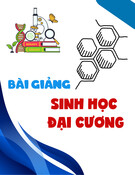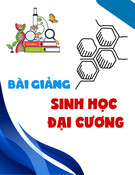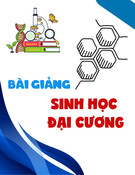
* Corresponding author.
E-mail address: ajaykumar@ycm.uni-mysore.ac.in (A. K. Kariyappa)
© 2015 Growing Science Ltd. All rights reserved.
doi: 10.5267/j.ccl.2016.2.002
Current Chemistry Letters 5 (2016) 109–122
Contents lists available at GrowingScience
Current Chemistry Letters
homepage: www.GrowingScience.com
Design, synthesis and biological evaluation of 1,3,4-oxadiazoles/thiadiazoles
bearing pyrazole scaffold as antimicrobial and antioxidant candidates
Pavithra Gurunanjappa and Ajay Kumar Kariyappa*
Post Graduate Department of Chemistry, Yuvaraja’s College, University of Mysore, Mysuru 570005, India
C H R O N I C L E A B S T R A C T
Article history:
Received October 21, 2015
Received in revised form
December 20, 2015
Accepted 12 Februray 2016
Available online
12 February 2016
A series of semicarbazones, thiosemicarbazones, 1,3,4-oxadiazoles/thiadiazoles bearing
pyrazole scaffold were designed and synthesized. All the synthesized new compounds were
characterized by 1H NMR, 13C NMR, MS and elemental analysis. The synthesized compounds
were screened to probe their in vitro antimicrobial activity against bacteria and fungi species.
The structure-activity relationship of the synthesized compounds was studied. The compounds
displayed good to excellent potency against tested microorganisms. The in vitro antioxidant
activities of the 1,3,4-oxadiazoles/thiadiazoles were evaluated by DPPH, hydroxyl and nitric
oxide radical scavenging assay. Among the tested compounds, compound with chloro
substitution showed good antioxidant potential.
© 2016 Growing Science Ltd. All rights reserved.
Keywords:
Antimicrobial
Antioxidant
Pyrazole
Semicarbazone
Thiosemicarbazone
1. Introduction
The pyrazole motif makes up the core structure of numerous biologically active compounds.
Compounds bearing pyrazole nucleus exhibit versatile range of biological activities such as
antimicrobial1, anti-inflammatory2, analgesic3 and GABA receptor antagonists and insecticides.4 In
addition to the diverse biological activities of pyrazoles, other heterocycles in association with
pyrazoles play a prime role in chemical and pharmacological fields. The prevalence of pyrazole cores
in biologically active molecules has stimulated the need for elegant and efficient ways to make these
heterocyclic lead.
Further, semicarbazone and thiosemicarbazone are excellent prototypes for the design and
development of novel amino oxadiazole and thiadiazole respectively. In addition semicarbazone have
received significant attention from pharmaceutical industry due to their wide spectrum of biological
activity such as anticonvulsant,5 antioxidant,6 antimicrobial activities7 etc. Compounds containing
1,3,4-oxadiazole core were known to possess pharmacological properties such as antimicrobial,8 COX-
2 inhibitors and anti-inflammatory, antitumor and analgesic.9 The widespread use of 1,3,4-oxadiazoles

110
as a scaffold in medicinal chemistry established this moiety as a member of the privileged structures
class, among them the synthesis of 2-amino-5-substituted-1,3,4-oxadiazole has received a lot of
interest.
Sulpha drugs are well recognized for their various physiological activities. Thiosemicarbazone
derivatives have been the focus of medicinal chemists because of their potential biological activities.10
Thiosemicarbazones are very useful intermediate for the development of molecules of
pharmaceutically important molecules, as well as they themselves possess antimicrobial, antiviral,11
anti-HIV12 and anticancer13 properties. 1,3,4-Thiadiazoles have gained importance as they constitute
the structural features of many bioactive compounds. These compounds are of great interest in
chemistry owing to their bioactivity of certain plant growth regulating effects as well as antimicrobial
activity.14 1,3,4-Thiadiazoles possess a wide range of therapeutic activities like antioxidant, anticancer,
anti-inflammatory and hyperlipidaemia.15
In the pursuit and design of new drugs, the development of hybrid molecules through the
combination of different pharmacophores in one frame may lead to compounds with interesting
biological profiles. In view of these facts and as a part of our extensive research program, the synthesis
of 1,3,4-oxadiazole and 1,3,4-thiadiazole derivatives incorporating with pyrazole nucleus as hybrid
molecule possessing antimicrobial and antioxidant activity is aimed.
2. Result and discussion
2.1 Chemistry
The precursor 3-(2-hydroxyphenyl)-1-phenyl-1H-pyrazole-4-carbaldehydes, 1a-f were synthesized
from our earlier reported method.16 The synthetic route used to obtain the target 1,3,4-oxadiazole and
1,3,4-thiadiazole containing pyrazole moiety is outlined in Scheme 1. The synthetic strategy involves
the preparation of semicarbazones, 2a-f and thiosemicarbazones, 2g-l by the condensation of 3-(2-
hydroxyphenyl)-1-phenyl-1H-pyrazole-4-carbaldehydes, 1a-f with semicarbazide hydrochloride and
thiosemicarbazide hydrochloride respectively. The oxidative cyclization of semicarbazones, 2a-f and
thiosemicarbazones, 2g-l lead to the formation of 1,3,4-oxadiazolyl pyrazoles, 3a-f and 1,3,4-
thiadiazolyl pyrazoles, 3g-l.
The synthesized new compounds were characterized by spectral analysis before being evaluated
for their in vitro antimicrobial and antioxidant activities. In 1H NMR spectra, compounds 2a-f showed
signals in the region δ 4.810-4.835 ppm, δ 6.625-6.652 ppm and δ 8.010-8.115 ppm which were
assigned to NH2, CONH2 and CH=N protons respectively. Compounds 2g-l showed the signals in the
region δ 2.212-2.430 ppm, δ 4.515-4.621 ppm and δ 8.142-8.244 ppm were assigned to NH2, CSNH
and CH=N protons respectively. The signals observed as singlet in the region δ 10.20-10.40 ppm for
the CHO protons of 1a-l were absent in 2a-l. In 13C NMR spectra, the CONH2 and C=N carbons of 2a-
f appeared in the region δ 156.62-158.45 ppm and δ 143.42-143.63 ppm while, CSNH2 and C=N
Scheme 1. Synthesis of 1,3,4-oxadiazolyl/thiadiazolyl pyrazoles

P. Gurunanjappa and A. K. Kariyappa / Current Chemistry Letters 5 (2016)
111
carbons of 2g-l appeared at the region δ 178.64-179.22 ppm and δ 142.75-143.18 ppm respectively.
These spectral data support the formation of semicarbazones 2a-f and thiosemicarbazones 2g-l.
The compounds 3a-l showed a singlet for two protons in the region δ 3.566-4.112 ppm for NH2
protons in their 1H NMR spectra. The signals are observed for CONH/CSNH and CH=N protons of
2a-l were found absent. In their 13C NMR spectra, the signals due to two N=C-O and N=C-S carbons
appeared in the region δ 164.15-176.14 ppm. Further, all compounds showed signals due to aromatic,
substituent protons and carbons in the expected region. Synthesized new molecules showed M+1 ion
peak as a base peak in their mass spectra. Further, the analytical data obtained for the compounds 3a-l
were in good agreement with theoretically calculated data. All these spectral and analytical results
confirmed the formation of the products.
2.2. Antimicrobial activity
Microbial studies of synthesized compounds were assessed by minimum inhibitory concentration
(MIC) by serial dilution method17. The compounds were screened for their antimicrobial activities
against Gram-negative bacteria species Escherichia coli, Pseudomonas aeruginosa, Gram-positive
bacteria Staphylococcus aureus, fungi species Aspergillus nigar, Aspergillus flavus and Candila
albicans. The experiments were carried out in triplicate; the results were taken as a mean of three
determinations. Known antibiotics ciprofloxacin and fluconazole were used as standards for
antibacterial and antifungal studies respectively. The results of MIC’s were summarized in Table 1 and
Table 2.
Table 1. MIC’s of the test compounds 2a-l against bacterial and fungal species
Compound
No.
Minimum inhibitory concentration (MIC’s) in µg/mL
S. aureus E. coli P. aeruginosa A. niger A. .flavus C. albicans
2a 25 25 50 25 25 50
2b 25 12.5 12.5 12.5 25 25
2c 50 25 25 25 25 50
2d 25 25 25 25 50 50
2e 25 12.5 25 25 25 25
2f 50 75 100 75 75 ---
2g 25 50 12.5 25 50 25
2h 12.5 12.5 12.5 25 25 12.5
2i 25 12.5 12.5 25 50 25
2
j
50 25 12.5 25 50 25
2k 50 25 12.5 25 50 50
2l 50 75 100 75 75 100
ciprofloxacin 25 12.5 12.5 ---- ---- ----
fluconazole ---- ---- ---- 12.5 25 25
The synthesized semicarbazones and thiosemicarbazones exerted a wide range of modest to good
in vitro antibacterial activity against the tested organisms. Compounds 2a, 2g having no substitutions,
and 2d, 2j with methoxy substitution on the aromatic ring showed moderate activity against tested
species. Compounds 2c, 2e and 2k having CH3 substituent showed moderate activity and compound 2i
containing CH3 substitution exhibited equal activity compared with that of standard. It has been
interesting from the results of the study that chloro substitution in the synthesized compounds enhanced
the activity to the greater extent. 2b demonstrated excellent activity against all and 2h against S.aureus
organisms. Nitro substitution present in compounds 2f and 2l retarded the inhibitory effect against the
organism tested.
Compounds 2a and 2g showed moderate antifungal activity against the tested species. Compounds
2c, 2e, 2i and 2k having methyl and 2d, 2j having methoxy substitution showed moderate activity.
Compounds 2b and 2h having chloro substitution exhibited inhibition to a remarkable extent; while 2f
and 2l with electron withdrawing nitro substitution showed lesser activity against the tested organisms.

112
Table 2. MIC’s of the test compounds 3a-l against bacterial and fungal species
Compound No. Minimum inhibitory concentration (MIC’s) in µg/mL
S. aureus E. coli P. aeruginosa A. niger A. flavus C. albicans
3a 25 25 25 25 25 50
3b 25 12.5 12.5 12.5 25 25
3c 25 12.5 25 25 25 50
3d 25 12.5 25 25 25 50
3e 25 25 25 25 50 25
3f 50 75 100 75 100 50
3g 25 25 50 25 25 50
3h 12.5 12.5 12.5 12.5 25 25
3i 25 50 12.5 25 50 25
3j 50 12.5 25 12.5 25 50
3k 50 25 25 25 25 50
3l 50 100 75 100 50 50
ciprofloxacin 25 12.5 12.5 ---- ---- ----
fluconazole ---- ---- ---- 12.5 25 25
The synthesized new 1,3,4-oxadiazoles and 1,3,4-thiadiazoles demonstrated moderate to excellent
antibacterial and antifungal activity by inhibiting the tested organisms. Compounds, 3a, 3g showed
moderate activity, chloro substituted compound 3b showed excellent antibacterial activity against all
the tested organisms. Compound 3h showed the highest activity against Staphylococcus aureus
compared with standard ciprofloxacin. Compounds 3c, 3e, 3i and 3k having methyl substitution
exhibited moderate to good activity, 3d and 3j having methoxy substitution showed good activity,
Compounds 3f and 3l having nitro substitution exhibit lesser activity against the organisms tested.
Compounds 3a, 3g having no substitution, and compounds 3d, 3j having methoxy substitution
exhibited moderate activity against the fungal species tested. However, compounds 3c, 3e, 3i and 3k
having methyl substitution showed moderate to good activity. Chloro substitution present in 3b and 3h
demonstrated excellent activity and 3f and 3l having nitro substitution exhibited lesser activity against
the fungal organisms tested.
In an attempt to interpret and correlate the molecular parameters of the small molecules with the
potency of inhibition against the various microorganisms, detailed quantitative structure-activity
relationship (QSAR) analysis was carried out. Physicochemical parameters for the small molecules
were computed18 and both pair-wise and multivariate analysis was carried out as specified in the
literature19,20. Further, parameters like LogP, aromatic bond content, molecular weight, number of
atoms and bonds were negatively correlated with inhibition potency.
Analysis of the results indicates that the small-molecule features that likely contribute to increased
potency of inhibition vary across different microorganisms. This is an encouraging observation since
specific variation of a particular molecular feature would lead to increased specificity towards a
particular kind of microorganism. Further, this analysis also points out to the parameters that can be
modulated to increase the potency of these compounds in general across the different microorganisms
employed. However, care must be exercised in interpreting these results given the small sample size
that was employed across compounds 2a-l and 3a-l and the fact that MIC was considered as the
dependent variable.
The effect of substitution in the aromatic ring of synthesised compounds has been studied based on
their in vitro antimicrobial activity results. Monochloro substitution in carbazone, 2b and
thiosemicarbazine, 2h; 1, 3, 4-oxadiazole, 3b and 1, 3, 4-thiadiazole, 3h bearing pyrazole scaffold
showed good antimicrobial activity. Among these scaffolds, ortho substitution 3b and 3h showed high
efficiency then para substitution 2b and 2h, in antimicrobial. So this suggest that ortho monochloro

P. Gurunanjappa and A. K. Kariyappa / Current Chemistry Letters 5 (2016)
113
substitution plays a very vital role in hamper the cellular architecture of E. coli, P. aeruginosa, S.
aureus, fungi species A. niger, A. flavus and C. albicans. Results suggest that 3h could actively inhibit
the growth of gram positive (S. aureus) and gram negative (E. coli and P. aeruginosa).
Comparative analysis illustrate that, among 2b/3b and 2h/3h shows that, sulfur moiety in 1, 3, 4-
thiadiazoles, 2h/3h act as potent inhibitor for both gram positive as well as gram negative bacteria. In
case of moderate electronegative elements like sulfur and chlorine containing compounds, 3h showed
better in vitro activities, comparatively then at of higher electronegative element oxygen, 3b. Therefore,
the substitution and position of chloro plays a very important role in enhancing the bioactivities of the
compound. Thus the in vitro data suggest that monochloro substitution at ortho position, 3h is most
favorable for enhancing the antimicrobial activity.
2.3. Antioxidant activities
2.3.1. DPPH radical scavenging activity
Antioxidants are characterized by their ability to scavenge free radicals. Proton radical scavenging
action is an important attribute of antioxidants, which are measured by DPPH scavenging assay. This
assay was performed by a method reported by Renuka et al.17 1 mL of DPPH solution (0.1 mM in 95%
methanol) was mixed with different aliquots of test samples (25, 50, 75 and 100 μg/ml) in methanol.
The mixture was shaking vigorously and allowed to stand for 20 min at room temperature. The
absorbance was read against blank at 517 nm in an ELICO SL 159 UV visible spectrophotometer. The
free radical scavenging potential was calculated as a percentage (I %) of DPPH decoloration using the
equation:
I% of scavenging = (A0-A1/A0) ×100
where A0 is the absorbance of the control reaction mixture excluding the test compounds, and A1 is
the absorbance of the test compounds. Tests were carried out in triplicate and the results are expressed
as I% ± Standard Deviations and were summarized in Table 3.
2.3.2. Nitric oxide radical scavenging assay
This assay was performed by a method reported by Padmaja et al.21 Nitric oxide (NO) was generated
from sodium nitroprusside (SNP) and it was measured by the Griess reaction. Nitric oxide was
generated by the sodium nitroprusside in phosphate buffer at physiological pH and then nitric oxide
was reacted with oxygen, produced the nitrite ions, which can be estimated by the Griess Reagent. 1
mL of Sodium nitroprusside (10 mM), 1.5 ml of phosphate buffer (pH 7.4) was mixed with the test
solution (25, 50, 75 and 100 µg/ml) and incubated 25 °C for 150 min, to this 1 mL of Griess reagent (1
% sulfanilamide in 2 % phosphoric acid and 0.1% N-(1-naphthyl) ethylenediaminedihydrochloride)
was added and allowed to stand for 3 min, the absorbance of the chromatophore was read at 546 nm.
Ascorbic acid was used as standard. The experiments were carried out at four different concentrations
in triplicates and the results are expressed as I% ± Standard Deviations and were summarized in Table
4.
2.3.3. Hydroxyl radical scavenging assay
Hydroxy radical scavenging assay was carried out according to the reported procedure.22 Product
formed by the degraded deoxyribose was on heating with thiobarbituric acid (TBA) form a pink colored
chromogen. This confirms the formation of OH·. The addition of the tested compound with the reaction
mixture, they distant the hydroxy radicals from the deoxyribose and prevent their degradation. This
experiment was performed by mixing 0.1 mL of phosphate buffer; 0.2 mL of 2-deoxyribose, test
solution (25, 50, 75 and 100 µg/ml), 0.1 mL of H2O2 (10 mM), 0.1 mL of ascorbic acid (1 mM), 0.1






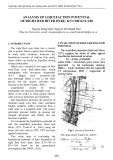
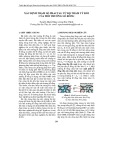

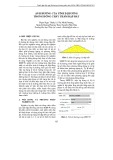
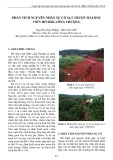


![Bài giảng Giáp xác chân mái chèo [mới nhất]](https://cdn.tailieu.vn/images/document/thumbnail/2025/20250927/lethihongthuy2402@gmail.com/135x160/92891759114976.jpg)



![Tài liệu học tập Chuyên đề tế bào [mới nhất]](https://cdn.tailieu.vn/images/document/thumbnail/2025/20250906/huutuan0/135x160/56151757299182.jpg)

